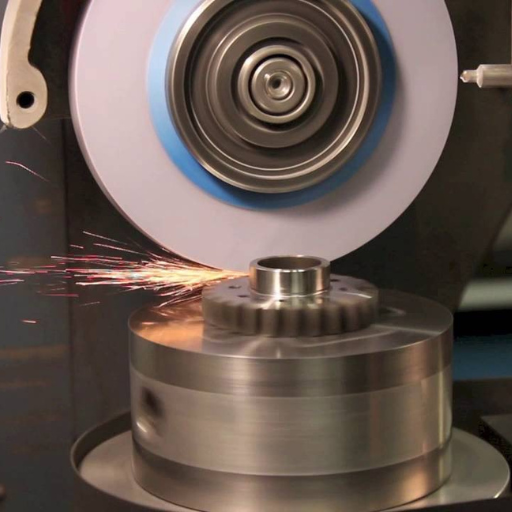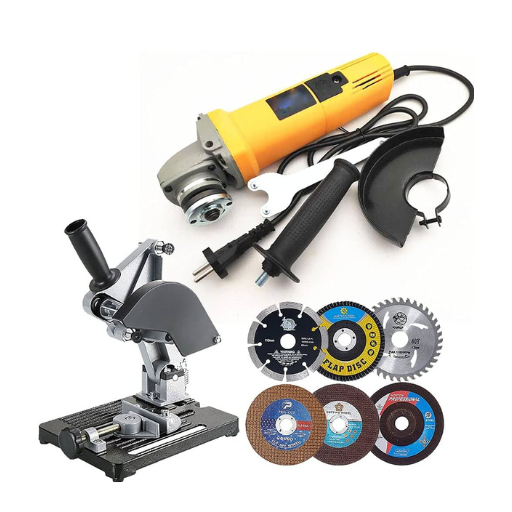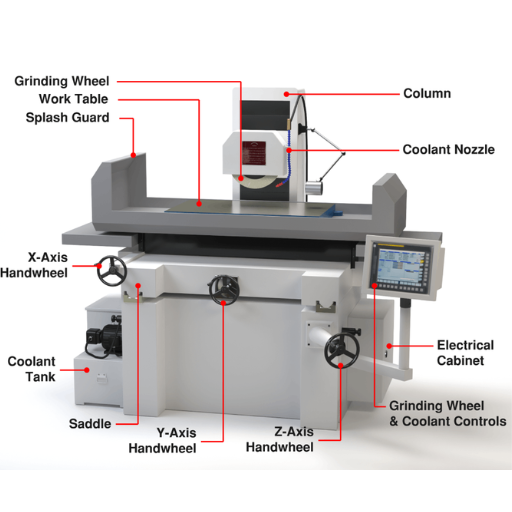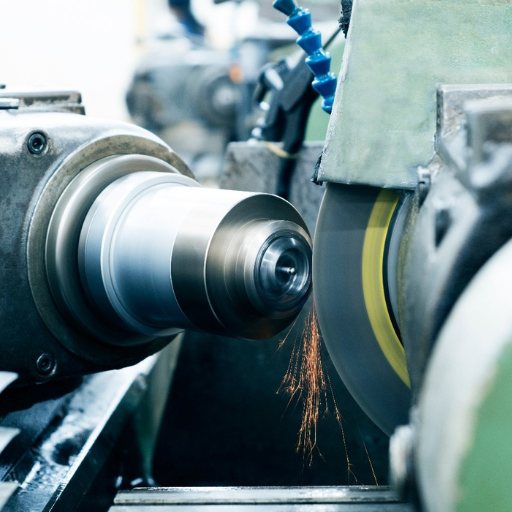Grinding machines have evolved significantly over the years, becoming vital components within diverse industrial processes. This blog aims to demystify the fascinating world of grinding machine technology, guiding readers through the fundamental concepts and progressing toward more intricate techniques. Whether you are a novice looking to understand the basics or an experienced professional seeking to deepen your knowledge, this comprehensive guide will provide valuable insights into the operations, applications, and advancements within this essential field. Join us as we explore the transformative impact of grinding machines within modern manufacturing and beyond.
What Are the Fundamentals of Grinding Machines?
Understanding the Mechanics of Grinding Wheels
Grinding wheels are the main tools for grinding machines, made up of abrasive particles organized in various forms. Among these, the key features include abrasive material, grit size, bonding material and wheel grade. Aluminum oxide, silicon carbide, diamond and cubic boron nitride are some of the common types of abrasives used depending on materials and finish required. Grit size defines particle size and thus affects workpiece surface finish as well as material removal rate. Bonding materials such as vitrified, resinoid, metal or rubber hold the grains together while also influencing strengths and durability of a wheel. The higher the hardness level indicated by grade numbers, a less tolerant to wear is this tool. A right choice of grinding wheel needs one to appreciate these aspects in order to match it with specific applications for maximum efficiency and accuracy during grinding.
The Role Played by Abrasive Materials in Grinding
Abrasive materials have great impacts on how efficient or effective grinding operations would be carried out through high friction that results into workpiece material removal process. They include:
Aluminum Oxide (Al2O3): It is characterized by toughness as well as being durable making it suitable for grinding steels and ferrous alloys amongst others; technical parameters:
- Hardness: 9 Mohs scale
- Typical grit sizes: 24-220
Silicon Carbide (SiC): It is harder and sharper than aluminum oxide hence ideal when it comes to grind cast iron, non-ferrous metals and non-metallic materials; technical parameters:
- Hardness: 9.5 Mohs scale
- Typical grit sizes: 16-180
Diamond: For instance hard materials such as ceramics, glass or carbides besides others are precisely machined using diamond abrasives; technical parameters:
- Hardness:10 Mohs scale
- Typical grit sizes: 60-3000
Cubic Boron Nitride (CBN): CBN is best-suited for grinding high speed steels and superalloys because it comes second to diamond in hardness; technical parameters:
- Hardness: 9.5 Mohs scale
- Typical grit sizes: 80-1200
These abrasives are embedded in the grinding wheel using various bonding materials, each of which influences the wheel’s performance:
- Vitrified bonds: Provide high strength and rigidity, ideal for precision grinding.
- Resinoid bonds: Offer flexibility and are better suited for high-speed applications.
- Metal bonds: Used for applications requiring high wear resistance.
- Rubber bonds: Provide smooth grinding action and are often used for finishing applications.
The choice of abrasive material and bonding agent depends on the specific requirements of the grinding task, including the material of the workpiece, the desired surface finish, and the operational speed of the grinding wheel. Each parameter, from grit size to bond type, plays a crucial role in achieving the desired precision and efficiency in grinding operations.
Differentiating between Surface Grinding and Cylindrical Grinding
Surface Grinding:
Surface grinding refers to a machining process using an abrasive wheel that rotates about its central axis to smoothen the flat surface of metals or non-metals. The main objective is to obtain an accurate surface finish as well as precise dimensions. A magnetic chuck or fixture holds down the workpiece while moving back and forth beneath a turntable or spindle.
Technical Parameters:
- Materials: Metals, Ceramics, Plastics
- Accuracy: Can achieve tolerances within ±0.0001 inches
- Surface Finish: Typically ranges from 16-32 micro-inches
- Grinding Wheel Speed: 3,600 RPM – 4,500 RPM
- Coolants: Required to reduce heat and improve finish
Cylindrical Grinding
Grinding of circular or cylindrical shapes is called cylindrical grinding. This gives the desired shape and finish as the workpiece is rotated and also fed past an abrasive wheel which removes material. It can be used very effectively for creating precise outer surface diameters and shaft-like components.
Technical Parameters:
- Material: Metals, alloys, ceramics, plastics
- Accuracy: Can achieve tolerances within ±0.0001 inches
- Surface Finish: Typically ranges from 8 to 32 micro-inches
- Grinding Wheel Speed: Up to 33,000 RPM depending on the diameter of the wheel
- Coolants: Must be applied in order to reduce thermal effects and ensure dimensional accuracy
However, they are both employed in different applications based on their specific advantages but it is mainly determined by the necessary shape and surface quality of a particular workpiece being machined. Thus, through understanding unique technical parameters and capabilities of individual methods, manufacturers can identify the most suitable grinding process for their specific needs.
Exploring the Various Types of Grinding Machines
From Bench Grinders to Advanced CNC Grinding Machines
The grinding machine’s complexity and capability vary greatly from simple bench grinders to sophisticated CNC grinding machines. The most basic grinding machinery is the bench grinder which is used mainly for hand-grinding tools or small objects. Their two varying-grit grinding wheels and an electric motor that rotates them at a high speed usually mark these machines.
- Bench Grinders
- Usage: Sharpening tools, light-duty work
- Versatility: Restricted to manual operation
- Accuracy: Low precision
- Power Source: Electric motor, typically 0.75 HP to 1.5 HP
- Wheel Speed: 3,000 to 3,600 RPM
On the other hand, CNC grinding machines are highly precise and efficient and can handle complex shapes and components. These machines are computer-controlled and can perform intricate grinding processes with great accuracy.
- CNC Grinding Machines
- Usage: Precise shapes, large production runs
- Versatility: Highly versatile, for different materials and shapes
- Accuracy: High precision; normally within ±0.0001 inches (±2.54 µm)
- Power Source: High-power motors exceeding 10 HP often.
- Wheel Speeds: Vary considerably – up to 33,000 RPM.
- Automation:CNC fully automated
Most Common Types of CNC Grinding Machines;
- Cylindrical Grinding Machines:
- Accuracy Levels : Achievable tolerances are within ±0.0001 inches (±2.54 μm).
- Applications : Shafts, bearing rings etc.
- Surface Grinding Machines:
- Surface Finish : Usual range is between 16 and 32 microinches.
- Applications : Flat surfaces with very smooth finishes required.
Centerless Grinding Machines:
- Advantages include: high through-put i.e., suitable for short as well as long production runs,
- Applications:Components such as cylindrical ones including those having irregular shape do not require support from a spindle .
With an understanding of the specific parameters of these grinding machines, manufacturers can choose the right machine for their production needs, ensuring both precision and efficiency are optimized.
Specialized Machines: Tool and Cutter Grinders
Tool and cutter grinders are special types of grinding machines used in fabricating, regrinding as well as reconditioning various cutting tools. These machines are essential for industries demanding high precision tools such as cutters, drills, milling cutters among many others. They are capable of grinding complex geometries and intricate details.
Key Features and Technical Parameters:
- Usage: Sharpening end mills, drills, tool bits etc.
- Versatility: For wide range of tool configurations and geometries
- Accuracy: High precision; normally within ±0.0001 inches (±2.54 μm)
- Power Source: Usually 1 HP to 5 HP motors
- Wheel Speeds: Adjustable from about 900 up to 6,000 RPM typically.
- Automation:CNC fully automated
Common Types and Applications:
Universal Tool and Cutter Grinders:
- Applications : Reprocessing different sizes of tools or different shapes in general
- Features : Rotating workhead with multiple axis movement
CNC Tool and Cutter Grinders:
- Applications : Complex shaped tools with large production runs
- Features : Computer Numerical Control (CNC) for automation purposes involving precise tool setting and allowing multiple grinding operations on one set-up alone.
Surface Grinder Attachments:
- Applications : Smooth finishes required during fine surface grinding of tools
- Features: Attachments that convert surface grinders into tool grinders
By selecting the appropriate type of tool & cutter grinders, you can maintain sharpness longer without replacing costly-tools hence enhancing productivity while reducing operational costs. Understanding these features ensures that the correct grinder is chosen for precise maintenance scheduling.
The Evolution of Cylindrical Grinding Machines
Every since the invention of cylindrical grinding machines, its improvement has gone through various milestones towards the betterment of precision, efficiency, and versatility in each case. They were initially manually operated machines which demanded skilled technicians to attain accuracy required. This was followed by gradual integration of hydraulic, pneumatic and eventually electronic systems which made it possible to achieve better results on a more consistent basis.
The introduction of CNC (Computer Numerical Control) systems marked a significant shift in the development of cylindrical grinding machines. The use of CNC technology in manufacturing enhanced automation and precision in grinders. This step led not only to higher quality products but also shortened production time and reduced costs. With several axes, high resolution feedback devices and ease-of-use software being installed into modern CNC cylindrical grinders, they can be used across many industries like automotive as well as aerospace.
Technical Parameters for Modern Cylindrical Grinding Machines:
- Grinding Wheel Speed: Typically 5k – 10k RPM depending on material type and desired end finish.
- Workpiece Speed: Variable within the range 30 – 500 RPM based on materials characteristics as well as part size.
- Grinding Head Power: Depending upon machine capacity and intended purpose power rating may vary from few HPs up to 50 HPs most often.
- Machine Control System: Advanced touch screen interfaces with real-time monitoring provided by advanced CNC units having user-customizable programs.
- Accuracy: High levels of precision are maintained with tolerances that are normally ±0.0001 inches or even better than that.
- Coolant System: Integrated cooling system for tool life preservation during cutting operations is an integral part and requirement for all such types machines.
- Automation Options: Features include automated loading/unloading systems, robotic arm integration, gauging during machining process etc
- Dimensions &Weight Capacity: Machines can handle workpieces ranging from small bolts to large shafts with varying weight capacities up to several tonnes.
- Table Travel: Generally have extensive X and Z axes travel distance, thus being able to accommodate different sizes of milled parts.
- Software Features: Functions include adaptive control, collision detection and remote diagnostics.
These modern cylindrical grinding machines are now being used by precision manufacturers to develop high-quality products with efficient production.
The Anatomy of a Grinding Machine: A Closer Look
Core Components: The Grinding Wheel and Workpiece
A cylindrical grinding machine consists of a grinding wheel and workpiece, both of which form the main components that play vital roles during the process. An abrasive material such as silicon carbide or aluminum oxide constitutes the grinding wheel that revolves at high speeds to take off some of the workpiece’s surface. It has been designed to resist substantial forces without losing precision cutting ability. On the other hand, the work-piece is clamped and rotated at precise velocities. Consequently, it is the interplay between these two elements that defines how well finished part is or how accurately it matches its dimensions. In order to achieve desired results, there are specific adjustments for their materials, position and speed hence making them fundamental parts in any effective operating cylindrical grinding.
Electric Motors And CNC Control For Precision
Cylindrical grinding machines require electric motors and CNC control to be able to deliver high level accuracy.Electric motors provide consistent controlled power supply for rotating the grinding wheel at high speeds as well as accurate positioning of different machine parts. Key parameters of these motors are;
- Power Output: Typically 5 HP – 50 HP depending on size of machine.
- Speed: Different materials and processes require variable speeds between 1,500 RPM -10,000 RPM.
CNC (Computer Numerical Control) brings in another dimension of precision by automating and regulating this process with unmatched exactness.CNC systems use sophisticated algorithms and software programs that control the position and speed of rotation for both wheel head and work piece. Important technical parameters include:
- Positioning Accuracy: Normally within ±0.001 mm.
- Repetitive Positioning Accuracy: Grind wheels usually ±0.005 mm.
- Resolution: Fine adjustment can be up to 0.0001 mm.
These factors ensure a highly repeatable process with significantly reduced errors thus improving overall quality.The realization of very high levels precision in manufacturing comes through leveraging on electric motors and exploiting the capabilities of CNC control in cylindrical grinding machines.
Surface Quality Through Coolant and Abrasive Wheels
Coolant and abrasive wheels are critical in maintaining surface integrity during cylindrical grinding operations. The function of coolant is to minimize heat generation which can result into thermal distortion as well as surface burns. In addition, it helps to wash away chips from metals and other debris while keeping the wheel sharp. Some common coolants used include watersoluble, synthetic and semi-synthetic fluids.
Abrasive wheels are equally essential for achieving superior surface finishes.Abrasive wheel selection will depend on several factors such as material hardness, desired finish and grinding speed. Typical abrasives include aluminum oxide for general purpose grinding, silicon carbide for softer or more brittle materials, cubic boron nitride (CBN) or diamond for very hard ones. Regular truing and dressing of the abrasive wheels are required to maintain their effectiveness and prevent workpiece surfaces from being compromised.
By applying right coolant coupled with correct choice of abrasive wheels, continued success in producing high quality surface finishes free from defects in cylindrical grinding is attainable.
Advanced Techniques in Grinding
Art of high-precision and CNC grinding
Mastering the art of high-precision and CNC grinding entails using advanced methods and technologies to attain outstanding levels of accuracy as well as a fine surface finish. The modern CNC grinding machines are fitted with high-resolution encoders, linear motors, and sophisticated software that enable accurate control of grinding parameters. For instance, high-speed grinding, hard turning, adaptive control help retain dimensional accuracy and quality surfaces even in tough applications. Moreover, in-process gauging systems for instance facilitate use of real-time monitoring and adjustment hence reducing manual interventions; thus improving efficiency. Furthermore, operators need to be updated on developments in grinding wheel materials and coolant formulations so as to optimize the performance of both machine tooling life extension. High precision and CNC grinding are constantly evolving due to improvements in machine technology as well as process control therefore moving boundaries closer to what is possible in precision manufacturing.
The importance of tool geometry in grinding operations
Tool geometry is highly important for any grinding operation since it affects efficiency, quality and precision of the process significantly. Good tool geometry ensures that cutting edges are optimal which reduces wear on the grindstone while also minimizing thermal damage on work pieces. Concerns such as rake angles, reliefs and tool angles must be carefully designed to suit particular materials being processed plus their associated grinding conditions. Optimum geometry promotes chip formation in a way that improves surface finishes while at the same time decreasing power requirements during machining operations. In CNC Grinding accurate tool geometry plays a vital role by enabling realization of repeatable results with improved accuracies even minor deviations from desired values can lead to substantial performance drops. Therefore understanding correct tool geometries is critical for enhancing production rates plus ensuring good finishes in all kinds of grinds.
High-Speed Grinding And its Applications
High-speed Grinding (HSG) is futuristic manufacturing technique offering higher productivity along with enhanced level of precision used extensively across various industry sectors like automotive aerospace or tool making. The basic idea behind HSG lies in the utilization of grinding wheels that have high rotating speeds and may be up to five times higher than those commonly employed by conventional technologies. Such increase in speed leads to a reduction in grinding forces, translating into greater material removal rates and shorter cycle times.
Critical technical parameters during high-speed grinding are:
- Rotational Speed: Normally ranges between 60,000 and 100,000 rpm vis-à-vis the standard ones that lie within 20,000 – 30,000 rpm range.
- Cutting Speeds: Typical HSG cutting speeds reach as much as 180 m/s while traditional methods rarely go beyond 30-60 m/s.
- Feed Rate: High feed rates are used in HSG resulting into faster material removal (0.5-1.5 mm/s).
- Wheel Composition: Advanced abrasive materials such as cubic boron nitride (CBN) or polycrystalline diamond (PCD) are often used for withstanding extreme temperatures and loadings.
Some uses of High-Speed Grinding include:
- Automotive Industry: it helps to enhance production of precise elements like camshafts and crankshafts aimed at boosting engine performance,
- Aerospace : manufacturing highly precise turbine blades among other critical components which require strict tolerances,
- Toolmaking: producing high quality cutting tools which are sharp and durable thus maintain extremely tight tolerances during various machining operations.
HSG is significant since it contributes to the creation of fine surface finish, improved dimensional accuracy as well as increased output levels; hence being a vital process in modern precision manufacturing.
Maintenance and Safety Tips for Grinding Machines
Routine Maintenance for Safe Operations
Regularly maintaining grinding machines is important for safety and efficiency. Some routine maintenance tips from my experience include the following:
- Daily Inspections: Starting with a daily machine check that includes the grinding wheel, electrical wiring, and coolant systems enables me to identify any visible wear or damage.
- Lubrication: Moving parts should be lubricated often. I refer to manufacturer’s instructions so as to have well-oiled machine parts that work smoothly.
- Wheel Balancing: So as to prevent vibration and achieve the best possible grinding performance, I consistently balance grinding wheels correctly.
- Cleaning: After every use, I clean it thoroughly in order to remove metal chips which might cause damages over time.
- Checking Bolts and Fasteners: Tightening of all bolts and fasteners is another part of my routine which is aimed at preventing any mechanical failure during its operation.
- Coolant System: I also examine the coolant system regularly just to make sure it is functioning properly because correct cooling is essential in order not to overheat and increase life of the grindstone.
- Documentation: In conclusion, keeping a comprehensive record about maintenance helps me see patterns of wear in good time and forecast repairs or replacements in future.
- Safety Guards: For instance, whenever am using this machine; I usually inspect the condition and positioning of safety guards so that they offer adequate protection during operation.
- Operator Training: Consistently training operators is key especially when we want them to know safe operating practices as well as potential issues before they become big problems.
- Scheduled Downtime: Lastly, scheduling downtime enables me conduct thorough inspection as well more in-depth planned maintenance without necessarily being worried about meeting immediate production demands.
Through these maintenance routines I can confidently run grinding machines knowing they are in good shape for use and are safe for me while operating with them.
To comprehend Safety Features of Grinding Machines
The knowledge on safety features will enhance safe usage of grinding machines. First these include modern grinding machines which have emergency stop buttons that will turn the machine off immediately in case of any emergencies. Additionally, the operation of these machines is often prevented by interlocking guards until the machine is enclosed safely. Most of them also contain overload protection systems that shut down the machine when too much force is applied to it for motor safety purpose. Moreover, there are spark arrestors and dust extraction systems; hence very few fire hazards may occur when using this equipment and a clean working environment can be maintained. Some grinding machines come with automatic wheel balancing and dressing systems which minimize the likelihood of wheel imbalance as well as potential accidents occurring. Consequently, by understanding how each feature works I have been able to use these machines with confidence.
Protective Equipment and Practices for Safe Grinding Operations
To ensure my own safety during grinding operations, I observe several essential precautions regarding protective equipment and practices as follows: Firstly, to keep flying debris or sparks out of my eyes I wear appropriate personal protective equipment (PPE) such as safety goggles or face shields. Also upon wearing hearing protections it helps to save me from noise induced hearing losses due to high decibel levels from grinding machines. Additionally, I put on gloves that offer dexterity and protect against sharp edges & hot material too. Respiratory protection especially during long hours of work is also used in order to guard against hazardous dusts inhalation.
My practices focus on making sure that the work environment is airy and there are no inflammable substances to reduce the risk of fire occurrence. I usually check the wheel of the grinding machine for any signs of damage before employing it as stated by the machine manufacturer. Moreover, to prevent accidents, I tightly hold my working tool and work piece while at the same time being watchful on how the operational condition of a machinery develops. Moreover, running machines unsupervised has never been practised by me and also I keep grinding wheels in a dry place to avoid absorbing moisture. By following these protective equipment’s and practices always, I manage to improve my safety when doing grinding operations.
Reference sources
1. What is a Grinding Machine: Definition, Types, Applications – 3ERP Blog
Link: 3ERP Blog
Summary: This blog post provides a comprehensive overview of grinding machines, covering definitions, various types, and their applications. It delves into the mechanics of how grinding machines work, highlighting the role of abrasive wheels in the process. This source is highly relevant for beginners who need to understand the foundational aspects of grinding technology, as well as those looking to explore the practical applications in different industries.
2. Mastering Grinding Work: A Comprehensive Guide – TRDSF Blog
Link: TRDSF Blog
Summary: This guide not only covers the technical aspects of grinding but also includes safety measures, tips for effective grinding, and future trends in the industry. It’s a valuable resource for both novices and experienced professionals seeking to enhance their knowledge and skills in grinding work. The guide’s focus on safety and future trends makes it particularly useful for those interested in staying updated with industry advancements.
3. Machining 101: What is Grinding? – Modern Machine Shop Online
Link: Modern Machine Shop
Summary: Modern Machine Shop’s article offers an in-depth look at the grinding process from a machining perspective. It explains the fundamental principles of grinding, describes different types of grinding machines, and discusses their applications in precision machining. This source is credible and detailed, making it suitable for readers who want a thorough understanding of grinding techniques and their critical role in manufacturing high-quality components.
Frequently Asked Questions (FAQs)
Q: What is the basic principle of grinding machine technology?
A: The basis for grinding machine technology is to remove material from a workpiece by means of a hard, abrasive surface such as a grinding wheel. These machines are available in different types and sizes to handle everything from finishing surfaces to accessory shaping metals and other materials. They do this by making a small chip on the workpiece, which is typically 0.25mm to 0.50mm deep, for highly accurate finishing operations.
Q: How does a surface grinder operate and where it fits best?
A: A Surface Grinder gives a smooth finish on flat surfaces. This works by turning an abrasive wheel that grinds the surface of the material. The most common use for surface grinders is precision work on metals which can be ground with very high precision to get a good finish. Thus, they are ideal for finalizing parts that need minimal roughness and close tolerances.
Q: Can materials other than metal be processed using cylindrical grinders?
A: Yes, cylindrical grinders used mainly for forming the external shape of cylinders can also be used with non-metallic materials such as plastics and rubber. These machines rotate the workpiece using handwheel while the grinding wheel contacts it so that meniscus-shaped chips can be cut away to form both roughing and finishing operations around cylindrical shapes. However, specific materials’ compatibility relies on the type of abrasive wheels employed as well as machine settings.
Q: What are some benefits of finishing with angle grinder?
A: Angle grinders have flexibility in terms of completing different sections especially in metals perfectly well hence giving users more freedom in how their projects should appear like after completion processes have been done on them at various stages using other supplementary equipment like cutting tools among others too that assist them attain smooth finishes at all time their jobs when working within accuracy parameters stated above.
Q: How are larger models distinguished from smaller ones?
A: Large grinding machines are designed to support bigger and heavier-duty work pieces which require additional power and a greater contact area for shaping heavy metals or large surfaces. In addition, they can exert more force on a larger area, thereby removing more material – thus, making them suitable for industrial applications where the focus is on high rates of productivity and efficiency. Meanwhile, smaller models offer higher precision though they are less powerful since fine work is easier with them when dealing with small parts.
Q: How do tool grinders contribute to productivity increase in woodworking and metalworking?
A: Tool grinders are important assets in both woodworking and metalworking industries as far as the accuracy and sharpness of cutting tools are concerned. These machines accomplish this by sharpening tools using grindings; thereby prolonging their working life through wearing down less over time while enabling a better quality cut and increased accuracy of the part being machined. If coupled with metal working activities then one can end up with an attractive finish after grinding thus improving productiveness while in woodwork it implies that there will be more accurate cuts made hence enhancing productivity a great deal plus meeting certain standards that customers expect from such artisans regarding these facilities within limited frameworks specified above as well.














